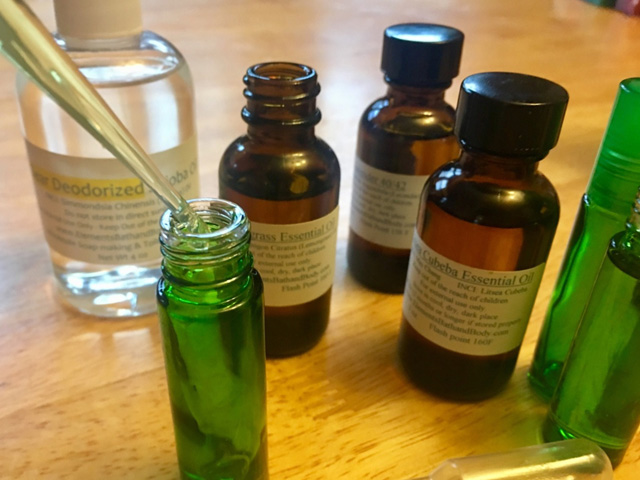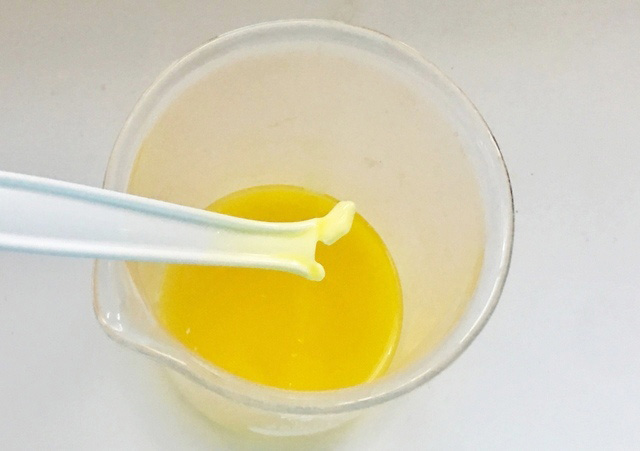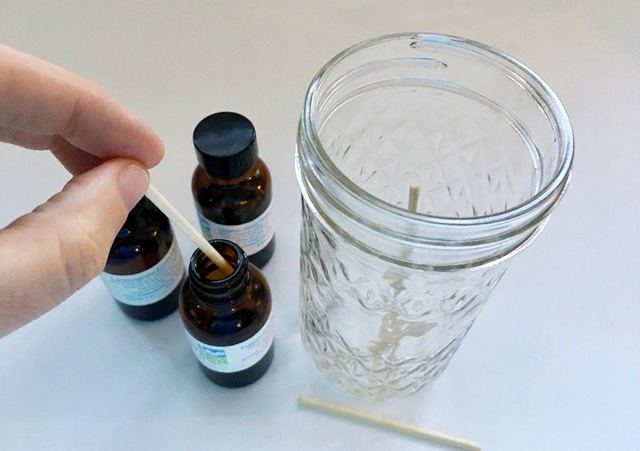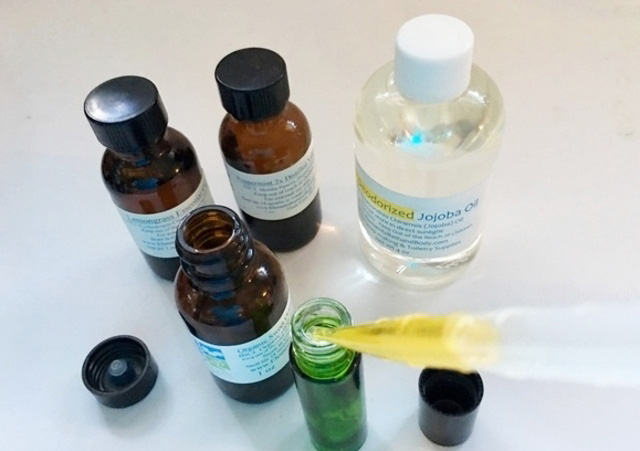
How to Blend Essential Oils
Adding scent to your soaps, bath bombs, lotions and more with Essential Oils (also referred to as “EO” for short) is a fun, natural way to give your products a beautiful fragrance and blending your own fragrance combinations is also a great way to express your creativity. If you’ve always dreamed of having a signature scent unique to you or your brand, blending essential oils can be a rewarding and creative endeavor and we’d love to help you along that process.
Many people would like to use essential oils in their products, but many are unsure of where to start. This tutorial will address everything you need to know from essential oil safety to how to create balanced EO blends. We have even included a quick and easy tutorial teaching you how to make a perfume roll-on to sample your essential oil blend creations along with a few EO blend suggestions to help get you started.
It’s good to note as well that there is exciting research demonstrating therapeutic properties of essential oils, however, it is beyond the scope of this tutorial so we will not be discussing that aspect of essential oils. Please remember, you should not make any medical claims regarding the products you make for sale unless you submit proper testing to the FDA, Health Canada or your country’s regulating body. Some examples of medical claims include:
- Treats psoriasis
- Relieves pain
- Cures acne
- Good for eczema
You can claim that your products have a beautiful, relaxing, calming, uplifting or invigorating scent, however! Just be sure that you are respectful of the health and safety guidelines and regulations that apply to you and your products.
Now, let’s get started!
What is an Essential Oil?
Essential oils are non-polar (not water soluble) extracts from the roots, seeds, bark, berries, leaves or flowers of plants. Some essential oils are expressed, meaning they are directly squeezed from the plant matter. Citrus essential oils, made from citrus rinds, are often expressed because they are particularly full of essential oil and there is an abundance of citrus rinds produced as a byproduct of the citrus industry.
While a few essential oils are expressed, most are steam-distilled. During steam distillation, the plant source material is heated to produce fragrant steam. That steam is collected by a condenser cooled with cold water or ice. The condensation collected is composed of two fractions: the water soluble fraction is called the hydrosol and the oily fraction floating on top is the essential oil. Hydrosols are quite fragrant themselves, and can be used as room sprays, facial mists or as an ingredient in lotions. Rose hydrosol, also known as rose water, is also used in Middle Eastern cooking. It takes quite a lot of plant starting material to make one tiny bottle of essential oil. Five pounds of peppermint leaves are needed to make one ounce of essential oil. For some plants, even more starting material is needed. One hundred eighty pounds of roses are needed for a single ounce of precious essential oil – that’s approximately 60,000 roses! Because of this discrepancy, essential oils can vary in price quite a bit.
You may have seen absolutes or concretes available from different suppliers. Absolutes are made by extracting the starting plant material with a solvent like hexane to yield a concrete. This concrete is extracted with ethanol to yield a highly concentrated absolute. Absolutes are usually quite expensive and mostly used by perfumers. The use of absolutes in soaps, lotions, and bath products is usually cost prohibitive.
Safety Considerations
Each essential oil is comprised of a medley of aromatic chemicals. Some examples of these chemicals include linalool, citral, limonene, eugenol and cinnemaldehyde. These compounds are quite volatile, so essential oils should be stored tightly capped in dark bottles to protect them from light. Some essential oils, especially those high in limonene like citruses, can degrade certain plastics. Always store or measure undiluted essential oils in glass or stainless steel containers. Look at this plastic spoon that was left sitting in sweet orange essential oil for a few hours!

Many people think that because essential oils are “natural”, they are always safe. This is only true, if essential oils are used at the correct dosage. Essential oils are made of chemicals and all chemicals have a maximum usage threshold for safety. Consider table salt, as an example. A little sprinkle of salt on your baked potato won’t harm you and is even essential for life. If you eat an entire pound of salt, however, you will likely die. Dosage is just as much a consideration with essential oils.
All essential oils should be diluted in either a carrier oil or in a product before applying to the skin. While a couple of essential oils may be safely applied “neat”, or undiluted, to the skin, it is considered safest to dilute all essential oils. Using essential oils neat can result in irritation, contact dermatitis, or increased photosensitivity (more below). How much should you dilute your essential oils? Well, that depends on what kind of product you are making. IFRA, the International Fragrance Association has different usage guidelines depending on what kind of product you are making. The three categories designated by IFRA that most concern us are leave-on products (lotions, creams), wash-off products (bath bombs, bath salts, sugar scrubs, bubble bath, body wash) and cold-processed soaps. Of these three, leave-on products have the lowest allowable usage rate and cold-process soap has the highest. An excellent resource for determining the safe usage for essential oils is eocalc.com. This calculator also lets you look up the correct usage for children’s products, lip products, alcohol based perfumes, deodorants, facial products, hairstyling and nail products, hot processed soaps, cleaning products, insect relents, melt and pour and liquid soap, mouthwash and toothpaste, perfume oils and solid perfumes, and shaving products in addition to the categories mentioned above.
In addition to being irritating if used incorrectly, some essential oils can be photosensitizing when used at too high of concentrations. While that may not be a concern in a foot cream you only wear at night, your certainly don’t want to use such a product on your face before you go to the beach! In particular, many citrus oils photosensitizing and should be used with some caution. According to Essential Oil Safety: A Guide for Health Care Professionals (2nd edition) by Robert Tisserand and Rodney Young (2013), the following citrus essential oils are NOT photosensitizing and can be used within normal IFRA guidelines:
- Lemon Oil (Steam Distilled)
- Bergamot Oil (Rectified, Bergaptene -Reduced)*
- Lime Oil (Steam Distilled)
- Orange Oil (Sweet)
- Tangerine Oil
- Yuzu Oil (Expressed or Steam Distilled)
- Lemon Leaf Oil
- Orange Leaf Oil
- Satsuma Oil (Expressed)
- Tangelo Oil
*Elements Bath and Body carries Rectified, Bergaptene-Reduced Bergamot Essential Oil
The following essential oils should not be used above the listed usage rate on skin that is to be exposed to the sun or a sun lamp within 12-18 hours of application (Tisserand and Young , 2013):
| Essential Oil | Maximum Usage Rate in Sun |
|---|---|
| Angelica Root | 0.8% |
| Bergamot (Unrectified) | 0.4% |
| Cumin | 4.0% |
| Grapefruit (Expressed) | 2.0% |
| Laurel Leaf (Absolute) | 2.0% |
| Lemon (Expressed) | 2.0% |
| Lime (Expressed) | 0.7% |
| Mandarin (Leaf) | 0.17% |
| Orange (Bitter, Expressed) | 1.25% |
| Rue | 0.15% |
| Taget (Oil or Absolute) | 0.01% |
Blending EO Fragrances
You may have heard of “notes” in a fragrance before. A balanced fragrance will contain at least one top note, a middle note and a base note. More complex fragrances will contain several of each. Top notes are bright, assortative notes that you first encounter in a fragrance. Top notes are also the most fleeting in a fragrance blend. They may disappear after only a few minutes. Middle notes are considered the heart of a fragrance that give it its identity. They can last for a couple hours. Base notes are said to anchor a fragrance. Many base notes have a sharp or pungent smell to them. You may dislike them alone and be quite surprised how they perform in a blend. (Keep this in mind, patchouli haters!) Base notes linger on your skin for many hours after application.
In addition to serving as different notes, different essential oils will have different scents. As a general rule, top notes tend to be weaker scents, though this is not always the case. Most citrus essential oils are quite weak relative to other oils. When you are making an essential oil blend, do keep in mind that if you use too much of a stronger essential oil, it will take over your blend entirely! I once made a batch of sweet orange, lavender, ylang ylang and anise soap and all I smelled was black licorice for months all because I used too much anise. When I blend a fragrance, I start with citrus, if I am using it, and build from there.
The table below summarizes the note and relative strength of different essential oils. Remember, you don’t have to follow this to the letter, though. As long as you are within IFRA guidelines, let your nose be your guide. Some essential oils can take on different notes in a blend, too, depending on the quantity used and the other essential oils surrounding it. Peppermint is a curious example; it is usually considered an assertive top note. When you use it in tiny quantities, however, it can act as sort of a base note, giving your blend an overall sweet freshness that is not immediately recognizable as minty.
| Essential Oil | Fragrance Note | Fragrance Strength |
|---|---|---|
| Anise | Top | Strong |
| Bergamot | Top to Middle | Medium |
| Cassia | Middle | Medium-Strong |
| Cedarwood | Base | Medium |
| Clary Sage | Middle | Medium-Strong |
| Clove | Base | Strong |
| Cinnamon Leaf | Middle to Base | Strong |
| Eucalyptus | Top | Medium |
| Ginger | Middle to Base | Strong |
| Grapefruit (Pink or White) | Top | Light |
| Lavender | Top to Middle | Light |
| Lemon | Top | Light |
| Lemongrass | Top to Middle | Medium |
| Litsea cubeba | Top | Medium |
| Lime | Top | Light |
| Neroli | Middle | Strong |
| Nutmeg | Middle | Strong |
| Palmarosa | Middle | Medium-Strong |
| Patchouli | Base | Medium-Strong |
| Peppermint | Top or Base | Medium |
| Rosemary | Middle | Medium |
| Rose Geranium | Middle | Medium-Strong |
| Spearmint | Top | Medium |
| Tangerine | Top | Light |
| Tea Tree | Middle | Medium |
| Sweet Orange | Top | Light |
| Vetiver | Base | Strong |
| Ylang Ylang | Middle to Base | Strong |
Let’s say you want to start making your own essential oil blends. How do you do this without wasting a lot of precious product? The two easiest ways are to use the wooden skewer method or to make a roll-on perfume. To use the wooden skewer method, you will need several wooden skewers broken into pieces (or use toothpicks or cotton swabs). Dip a skewer in the first oil of your blend you want to test. Let’s say you want to test an blend that is five parts sweet orange, three parts lemongrass, and one part patchouli. You will dip five skewers in the sweet orange, two in the lemongrass and one in the patchouli oil. Fan out all of the skewers in front of your nose and take a sniff. What do you think? Does the blend need more orange? Add another orange-dipped skewer. Is the lemongrass too strong? Take away one of the skewers. Once you have it where you think you might like it, place the skewers in a jar and let the scent mingle for a few hours. Open the jar, and let the scent waft into your nose. What do you think now? You might be surprised how your impressions might change! Always keep careful notes during this process—it’s easy to lose track of what you have done if you don’t’ write it down.

After you have an idea of a blend you like, you can next try it in a perfume roll-on. In addition to being a great way to try out essential oil blends, perfume oils make terrific gifts.
How to Make a Perfume Roll-On
To make a perfume roll-on you will need:
Start by placing between 16-24 drops of essential oil in the roll-on bottle. If we were testing our blend from above, we would use five drops of sweet orange, three drops of lemongrass essential oil and one drop of patchouli for a total of 18 drops. Top the rest of the bottle off with clear jojoba oil. Snap the roller ball on top, screw on the top and give it a good shape. You will want to try your new perfume oil, right away, but it will be better if you wait a few hours and let the scent mingle. Roll a little of your perfume on your wrist. What do you think of it? Is anything dominating the blend? Keep smelling it after a few hours. Do you still like it? If not, make adjustments.

Blending essential oils is an art that takes some practice to get good at. Some essential oils just go together well, like rosemary and lavender. Other combinations may surprise you. As a general rule, sweet orange goes with everything, so if you are stuck, try adding some of it to your blend.
Use Guidelines for Essential Oil Blends
Now that you have discovered an essential oil blend that you love, it’s time to start using it in your creations. Here’s how to go about doing that…
Let’s say that you have found that you really love a blend that contains:
10 parts sweet orange
5 parts lavender
2 parts spearmint
1 part peppermint
First you will need to convert that to a percent. Add up all of the parts and divide each of the parts by the total and multiply everything by 100%. In our example, the total is 18 parts, so
Sweet orange = (10/18) x 100% = 55.6%
Lavender = (5/18) x 100% = 27.8%
Spearmint = (2/18) x 100% = 11.1%
Peppermint = (1/18) x 100% = 5.6%
Now, decide how strongly you want your product to be scented.
For lotions, shampoos, body washes, melt and pour soap, and scrubs, you can scent your product with 1% essential oils for a light scent and 2% for a stronger scent.
Bath bombs generally require a little more essential oil because they will be dispersed in a tub full of water. Try 1.5% essential oil for a lightly scented bath bomb and 3% for a stronger product.
Cold processed soap needs the highest usage of all because the saponification process exhausts some of the scent (more below). For strongly scented soap, try 6% essential oils of the total oils you use in your recipe. For lighter-scented soap, try using 4% essential oils of your total oils in your recipe.
For example, let’s say we are using the blend above to make 3000g (101.4 oz.) of hand lotion. We would like our scent to be strong, so we will use 2% essential oils in our recipe. This means we will need 30g (2.03 oz.) of essential oils in our product (0.02 x 3000g = 30g OR 0.02 x 101.4 oz. = 2.03 oz.)
Now, multiply the percentage of each essential oil that you calculated above by the total essential oils needed in your recipe:
Sweet orange = 0.556 x 30g = 16.7g
Lavender = 0.28 x 30g = 8.4g
Spearmint = 0.111 x 30g = 3.33g
Peppermint = 0.056 x 30g = 1.68g
But, you are not quite done! You must make now sure that no single essential oil in your recipe exceeds the IFRA standards. You must check each essential oil you are using and make sure that you are not exceeding the maximum allowable amount. Enter the percentages of essential oils you used in your blend and that it is a leave-on product into eocalc. According to eocalc, this blend is safe to use at 2% in our product.
Using Essential Oils in Soap Making
We touched briefly on adding EO’s to your soaps above but here will dive in a little deeper. Essential oils make truly special cold processed soaps and are very popular with consumers. Because of the high pH and elevated temperatures achieved during saponification, there are a few points to consider which we will cover here.
It’s important to know that you will need a much higher percentage of essential oils in your soap than you would use in other products. It’s also critically important to note that not all essential oils survive the saponification process. For example, sweet orange and other citruses are particularly fleeting in cold processed soap. Folded citrus oil, such as 5x Folded Valencia Sweet Orange Essential Oil, have considerably more staying power. You will still want to use them with a heavy hand, however. Lime and bergamot have reasonably good staying power, lemon and orange are quite fleeting and pink or white grapefruit hardly sticks in soap at all. For grapefruit scented soaps, consider using a fragrance oil such as our Tangelo Fragrance. Some soapers choose to anchor their citrus blends in their recipe by using a little Litsea Cubeba Essential Oil or a bit of Patchouli Essential Oil. In particular, the Litsea does have a lemon-y scent, so consider swapping it for lemon in a recipe. I have not found patchouli to make citrus scents stick, but it is nice in a blend as a base note. Other soapers swear by using kaolin clay, or other additives to anchor a scent, thinking that the positively charged clay will adsorb the essential oils. Essential oils are not charged, so I think this might be wishful thinking. A teaspoon of kaolin clay per pound of oils in your soap recipe will not harm it, however, and you might like the slip that the clay gives to your bars so you can easily add it in without doing any harm. Some soapers advise soaping at cooler temperatures to preserve your essential oils. This is not a terrible idea, as long as you are aware of false trace. It likely won’t help your fragrance stick, however, because of the high pH that occurs during saponification. Ultimately there are a lot of “tricks” out there to consider but none have stood out to be the perfect answer so take them with a grain of salt and be sure to choose your essential oils with a good understanding of the information provided above.
In addition to disappearing scents, soap makers must be aware of the effects that different essential oils have on trace. In general, citrus essential oils slow down trace. If you are planning a design with intricate swirls, consider using plenty of 5x Sweet Orange, Valencia Essential Oil in your recipe. Geranium, palmarosa, and ylang ylang speeds up trace somewhat, and clove, cinnamon leaf, cassia, nutmeg, and ginger speed it up a lot more. I have found that a 100% peppermint soap accelerates trace a little bit, but if it is used at less than 25% of the total blend, it seems to have no ill effects. Neroli essential oil accelerates quite a bit and even causes the soap to rice. Consider stirring your essential oils into some of your base oils to minimize the ricing effect. If you are using an essential oil that accelerates trace in your design, plan accordingly and opt out of more intricate swirling designs. If you are making a layered design, don’t add the essential oils until you are ready to pour that layer. Essential Oils that have no discernable effect on trace include lavender, tea tree, lemongrass, Litsea cubeba, eucalyptus and spearmint.
And there you have it! Everything (or close to it) that you need to know to get started blending essential oils and adding them to your creations! Enjoy blending and remember to always take time to stop and smell the Rosemary Essential Oil.

Click Here to Shop all of our Essential Oils!
SHARE ON SOCIAL MEDIA
![]() Share this tutorial on Facebook
Share this tutorial on Facebook![]() Tweet about this tutorial
Tweet about this tutorial






